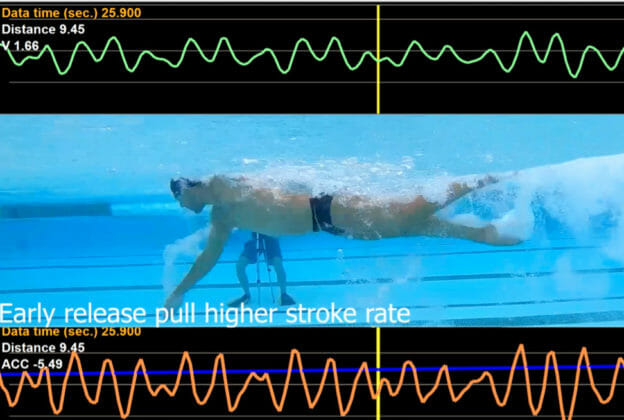Distance per Stroke vs Stroke Rate: the controversy continues.
A while ago, I got into a discussion with elite coach Jonty Skinner regarding a 50 meter freestyle race, swum by Freddie Bousquet back in 2010. Fred swam a very fast 21.3 in that race, which would have placed him second in the Olympic Games of Tokyo this year. In the final 8 meters into the wall, he clearly slows his stroke rate down from around 120 strokes/min down to around 112 strokes/min. Yet, he appears to maintain his speed, or even possibly speed up into the wall.
That can happen in only two ways. Either Freddie increased his propulsion or reduced his frontal drag, or he did both. My bet is that he did both.
One can see the intensity of the arm/hand entry increase in those final eight strokes. That increase in coupling energy alone would account for an increase his propulsion. We cannot comment on his underwater pulling motion, as we have no video of that. We also have to speculate that he may have reduced drag by releasing air bubbles from his nose under his chest on the final strokes.
The point is that he maintained or increased his speed with a slower stroke rate. Emma McKeon won the women’s Olympic 50 meter sprint race with the slowest stroke rate (115 strokes/min) in the field. Yet, she also demonstrated the most energetic coupling motions, driving her arms and hands aggressively to the water.
Faster stroke rate does not always lead to a faster swim.
We demonstrate this fact again with Olympian Brad Tandy. In comparing his early release freestyle technique with a 120 strokes/min with his full extension freestyle technique with a 111 strokes/min, we find Brad’s test is considerably faster with his longer, slower stroke rate.
This is not true of everyone, but in Brad’s case, which we show in this week’s video release, his slower speed with the faster stroke rate is clearly due to one flaw in technique. Using the early release technique, he repeatedly allows his right hand to turn in (in sweep) just in front of the shoulder. This mistake causes a significant loss of propulsion and velocity, accounting for the difference in speed.

Brad’s right hand turns in with the early release technique, leading to a significant drop in his speed (green graph above)
We hope you enjoy the video comparison this week, including my analysis. Just remember that when you increase your stroke rate, keep your grip (hold) on the water and don’t let go!
Yours in Swimming,
Gary Sr.


Thank you Sang! We really appreciate all the work you do in translating our videos. Consequently, we have a large South Korean audience. We are very grateful!